Welcome to ASNE's Exploration of Naval Engineering
This page covers the ships, people and places that propelled the growth of American shipbuilding and the rise of our dominant naval presence. We are actively growing this page regularly so please check back routinely for more content. If you have resources to share, please email us any time, education@navalengineers.org.
If you want to look at the Naval Engineers Journal from 50, 100 or 125 years ago, simply go to the magazine's publication page (membership required).
A quick overview:
- Virtual 360-degree tour of eight ships
- History of the USS Constitution
- Biographies of famous naval engineers
Tour the seven ships from the comfort of your Home!
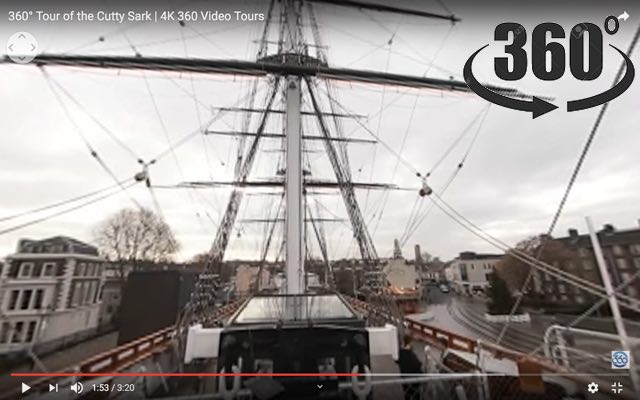
The Clipper Ship Cutty Sark
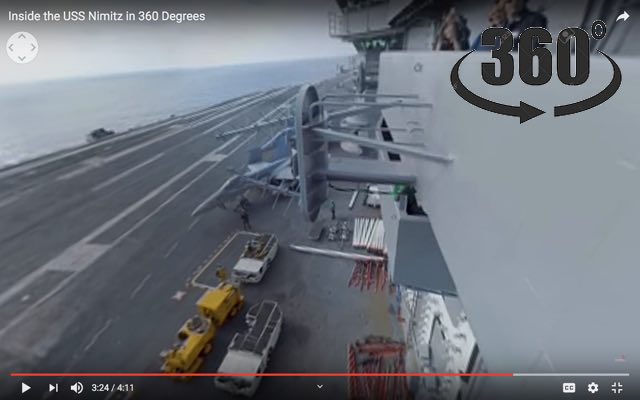
The aircraft carrier Nimitz
“Old Ironsides” Still a Symbol of American Naval Strength
The Naval Act of 1794 charged east-coast ship yards to build six frigates: Constellation, Constitution, United States, Congress, Chesapeake and President. These ships represented the best of American naval engineering and were comprable with the most technologically-advanced ships across the globe. The Constitution has been maintained for over 200 years by naval engineers. Here are some artifacts preserved from the Constitution and below you can read about parts of the Constitution's long and storied career. “Old Ironsides” is truly a national treasure!
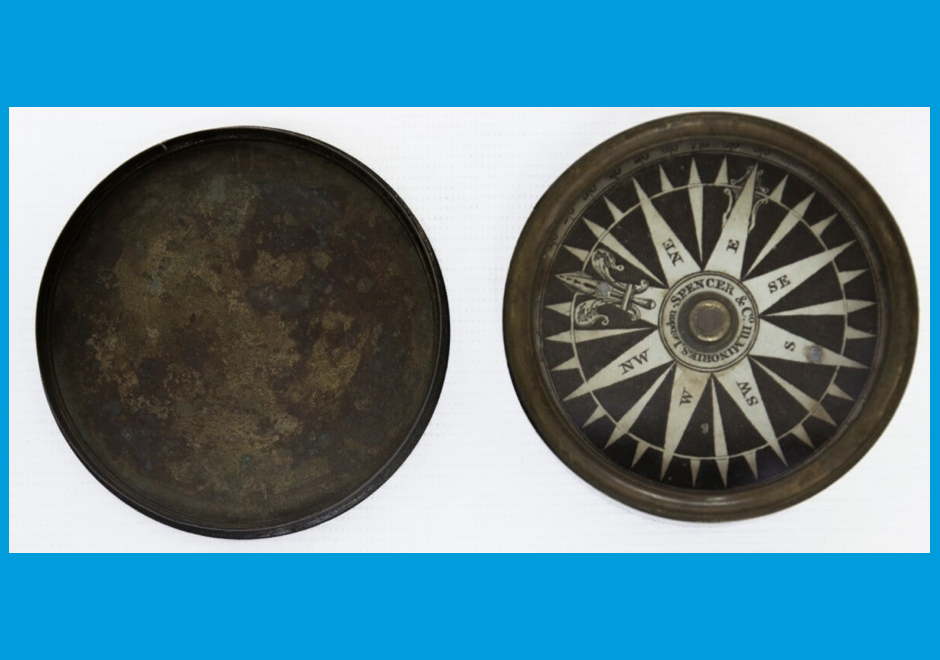
Compass from USS Constitution
This pocket compass was used aboard the USS Constitution as a navigation aid.

Copper Sheathing for USS Constitution
This sheeting was the original corrosion-resistance! Held in place with 500,000 copper nails, this sheeting still protects the 200+-year old beams.
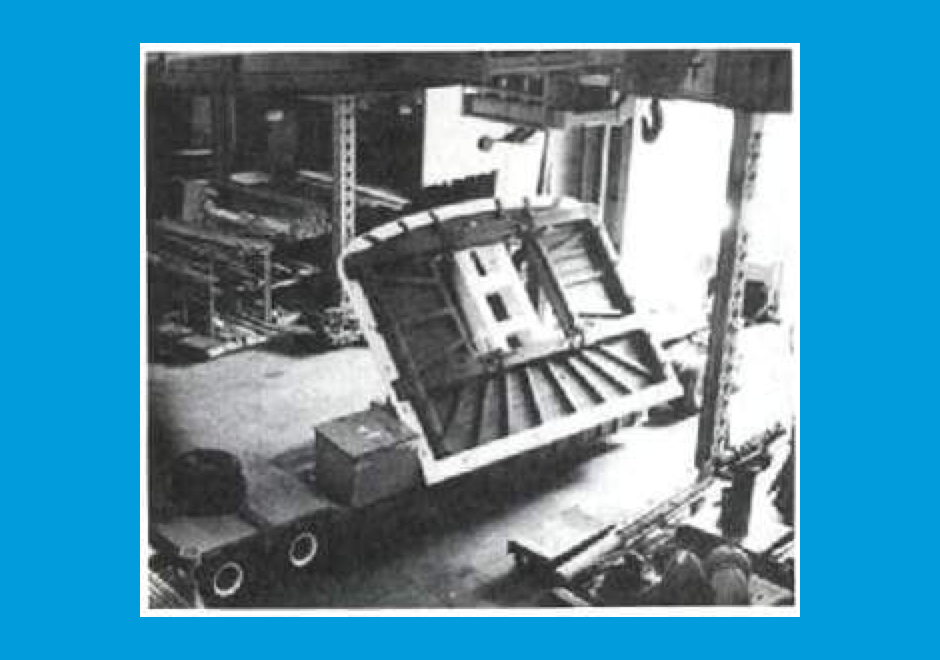
The USS Constitution Fighting Top
The fighting top has been painstakingly restored to keep it in its original pristine condition.
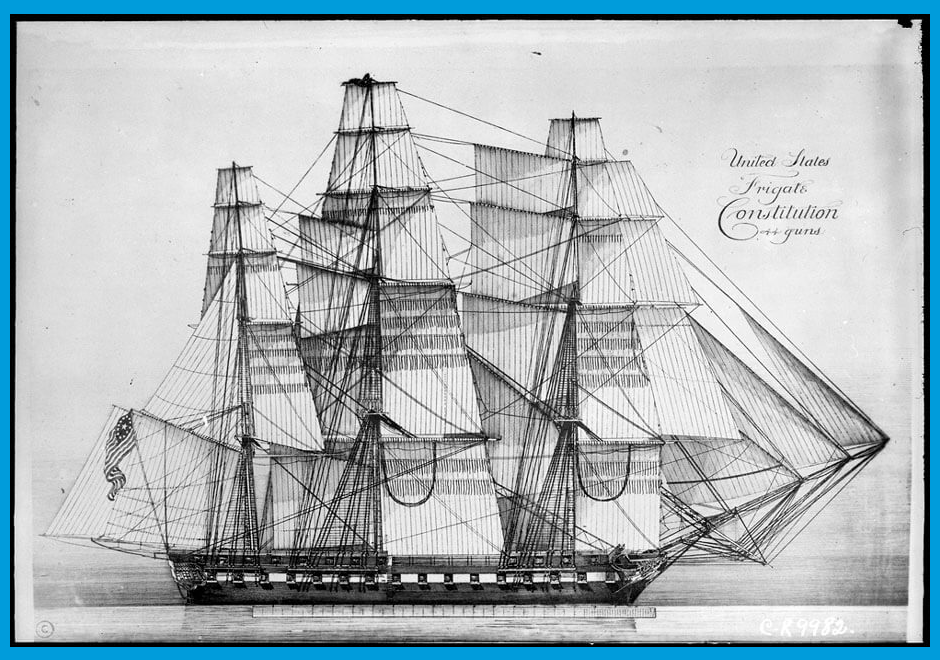
Original Sail Plan
This original plan details the lines and sails used to power this ship around the Atlantic.
Comparing the Designs of the USS Constitution and an 1840s whaling ship
This engaging video compares the measurements and abilities of two ships. It gives a comparison that highlights the unique strengths and characteristics of the USS Constitution.
The History of the USS Constitution
Following the American Revolution (1775-1783), the United States was a neutral and successful maritime trading party with England and France, countries that had been at war with each other since 1793. The British imposed embargoes and trade restrictions that restricted trade between France and America’s merchant fleet. In addition, Britain was desperate for sailors to man her 600-ship fleet, and impressed (kidnapped) more than 5,000 American sailors. Britain claimed they suspected the sailors they impressed were former English subjects and forced them to serve aboard her ships. As the U.S. moved forward in the 1800s, territorial disputes over the Canadian border and America’s western frontier strongly contributed to the onset of the war.
Following paragraphs from Navy.mil’s Constitution
The written instrument embodying the fundamental organic law and principles of government of the United States of America. Constitution, one of six frigates authorized by act of Congress, approved 27 March 1794, was designed by Joshua Humphreys, and built at Hartt's Shipyard, Boston, Mass., under the supervision of George Claghorn with Captain Samuel Nicholson as inspector. She was launched on 21 October 1797 and christened by Captain James Sever.
Into the trim frigate's construction went timbers from States ranging from Maine to Georgia, as well as copper bolts and spikes supplied by Paul Revere. A ship of beauty, power, and speed thus was fashioned as a national expression of growing naval interest, and a symbol auguring the dedication, courage, and achievement of American fighting men and ships.
Quasi War with France (1798-1801)
Following information comes from the U.S. Navy's USS Constitution's Battle Record and and the Naval History and Heritage Command's Constitution a
The Quasi War between the French and the Americans was waged from 1797 to 1801 in the Atlantic and the West Indies. The French sought to capture American ships, while the U.S. Navy protected American merchants and hunted down French privateers. The capture of the Sandwich in port by the crew of Constitution is an especially daring exploit of this quasi-war.
Constitution put to sea on 23 July 1798, commanded by Captain Samuel Nicholson, the first of many illustrious commanding officers. Following patrols along the Eastern Seaboard she became flagship on the Santo Domingo station, making several captures including the 24-gun Niger, the Spencer, and the letter-of-marque Sandwich. At war's end, Constitution returned to the Charleston Navy Yard where she was placed in ordinary.
The Barbary Wars (1801-1805)
Following paragraphs from Navy.mil’s Constitution and The Rebirth of the U.S. Navy and the Legendary Exploits of the Original Frigate Sailors
In 1803 amid growing demand for tribute and increasing seizures by the Barbary pirates, Constitution was recommissioned under Captain Edward Preble and sailed as flagship of the Mediterranean Squadron on 14 August. Preble took command of the squadron and vigorously brought the war to Tripoli, executing well-laid plans with brilliant success. On Constitution's decks tactics for destroying the captured frigate, Philadelphia, were laid as well as those for blockading and assaulting the fortifications of Tripoli. The small United States fleet on 3 and 7 August 1804 bombarded the enemy's ships and shore batteries with telling results.
Edward Preble’s temper was something already well known to those who served with him, and they understood where it came from: the British had burned his father’s house during the American Revolution, an act that would drive him to join the Navy. Then the British held him prisoner aboard the infamous prison ship Jersey where more than 10,000 Americans died with eight dying per day from starvation over the course of ten years. Preble survived and with him an understandable bad temper which would serve the Navy well.
Among his exploits in the Mediterranean, planning the blockade on Tripoli and ordering Lt. Stephen Decatur to recapture and burn the captured USS Philadelphia. The ship had been abandoned by its Capt. William Bainbridge who found himself on the wrong side of Preble’s judgment for having done so; Preble, it is said, believed Bainbridge and his crew should have chosen death over slavery.
After preventing Philadelphia from falling into enemy hands, Preble laid siege to Triploi in August of 1804. From Constitution, his Third Squadron flag ship, Preble forced many Tripolitans to move further into the countryside. Still, Tripoli showed no signs of surrender.
In addition to his temper, Preble was also relentless. He renewed the attack on Tripoli on Aug. 24, 1804 even though President Jefferson had failed to send reinforcements. Still, Preble had no fear. Preble’s persistent attack on Tripoli worked, forcing the Bashaw [ruler] of Tripoli to surrender to the Navy on June 4, 1805 and return all American prisoners of war including Capt. Bainbridge.
Commodore Samuel Barron and later Captain John Rodgers were next to command the squadron and Constitution, continuing to blockade and take prizes. Naval action thus generated a favorable climate for the negotiation of peace terms with Algiers, ending for a time our tribute payments. After the Tunisians agreed to similar terms in August, Constitution spent 2 years patrolling in maintenance of the peace. She sailed for home under Captain Hugh Campbell and arrived Boston in November 1807. Placed out of commission, the frigate was repaired in the succeeding 2 years.
In August 1809 she was recommissioned and became flagship of the North Atlantic Squadron, Commodore J. Rodgers, and in 1810 Isaac Hull was appointed her captain. The following year she carried U.S. Minister, Joel Barlow, to France and returned to Washington in March 1812 for overhaul. War with Britain impended and Constitution was readied for action. On 20 June 1812 the declaration of war was read to her assembled crew and on 12 July she took the sea under Captain Hull to rejoin the squadron of Commodore J. Rodgers.
On 17 July Constitution sighted five ships in company; supposing them to be Rodger's squadron, Hull attempted to join up. By the following morning, however, the group was identified as a powerful British squadron which included the frigates Guerriere and Shannon. The wind failed, becalming within range of the enemy who opened fire. Disaster threatened until Captain Hull astutely towed, wetted sails, and kedged to draw the ship slowly ahead of her pursuers. For 2 days all hands were on deck in this desperate and successful attempt at escape, a splendid example of resolute command, superior seamanship, and indefatigable effort.
2012-2015 marked the bicentennial of this conflict with England and her former North American colonies, a two-and-a-half year series of land and sea battles that has been referred to as the United States’ “Second War of Independence.”
Adapted from the excellent navy.mil summary "USS Constitution in the War of 1812". We made changes to add details and simplify some of the wording.
USS Constitution was developed and built in response to the threat of Barbary corsairs, which threatened American merchant shipping off the northern coast of Africa. Following the American Revolution, the United States' Continental Navy was disbanded, leaving the new nation without a credible seapower to defend its interests abroad. Signed into law on March 27, 1794 by President George Washington, the Naval Armament Act called for the construction of six frigates at shipyards along the eastern seaboard. The 44-gun USS Constitution was built in Boston, and launched on October 21, 1797.
War of 1812
Americans rallied around the slogan “Free Trade and Sailors’ Rights,” and the country was ready for war. The number of impressments became intolerable as Britain continued to fight Napoleon in France by harming Americans. President James Madison declared war on England on June 18, 1812.
At the outset of the War of 1812, USS Constitution had already won all of her engagements in two wars: the Quasi War with France (1798-1801) and the Barbary Wars (1801-1805). During the War of 1812, to the surprise of both the Americans and the British, she defeated four English warships, earning each of her three captains congressional gold medals. Upon returning to Boston from each victory at sea, the ship and her sailors were honored with parades and public adoration, and her legend grew into the national icon that “Old Ironsides” remains to this day.
![]()
USS Constitution was among the 22 commissioned warships of the United States’ 18-year-old Navy, compared to more than 80 British vessels on station off America’s eastern seaboard in 1812. While the American fleet boasted many successes during the War of 1812, their actions had little impact on the outcome of the war.
“Objective analysis of the War of 1812 must conclude that the victories of Constitution … had no direct effect on the course of the war,” explained Tyrone G. Martin in his history of USS Constitution, A Most Fortunate Ship.“The losses suffered by the Royal Navy were no more than pinpricks to the great fleet and did not disrupt the blockade of American ports… But, what Constitution did accomplish was to uplift American morale spectacularly and, in the process, end forever the myth that the Royal Navy was invincible.”
The Great Chase July 16 - 19, 1812
Less than a month after the United States declared war on Great Britain, USS Constitution, under the command of Capt. Isaac Hull was headed toward New York to join Commodore John Rodgers' squadron. Off the coast of Egg Harbor, NJ, she spent more than 50 hours outmaneuvering five English warships (HMS Aeolus, HMS Africa, HMS Belvidera, HMS GUERRIERE and HMS Shannon) in an agonizingly slow motion chase that proved her commanding officer’s leadership, her new crew’s teamwork, and her own ability to sail. In short, she demonstrated her readiness for the war and battles that lay ahead.
At about 4 p.m. on July 16, USS Constitution’s crew sighted an unknown ship to the northeast, which was joined by more ships early the next day - vessels Capt. Hull initially believed were American. “One Frigate astern within about five or six miles, and a Line of Battle Ship, a Frigate, a Brig, and Schooner, about ten or twelve miles astern all in chase of us, with a fine breeze, and coming up very fast it being nearly calm where we were,” Hull wrote to the secretary of the Navy a few days later. “Soon after Sunrise the wind entirely left us, and the Ship would not steer…”
Greatly outnumbered and desperate to outrun his British adversaries, Capt. Hull ordered the nearly 500 men under his command into action, to make the 2,200-ton ship lighter and sail faster. They discharged thousands of gallons of drinking water over the side and doused the sails with water to take full advantage of the occasional light winds. As a defensive measure, the Sailors moved long guns on the frigate’s spar and gun decks to point astern at the closing enemy vessels. Additionally, small boats were launched for a towing operation called kedging - carrying small anchors ahead of the ship to be dropped into the coastal waters, and then painstakingly using the capstan to pull the ship forward to the submerged anchors.
The English forces concentrated their own kedging efforts on moving a single ship closer and closer to the American frigate, while ineffectual shots were occasionally fired between the British warship and their distant quarry throughout July 17-18.
By about 4 p.m. on July 18, USS Constitution had a 3-4 mile lead over her nearest pursuer. Hull ordered his men to shorten the ship’s sails in preparation for a squall a few hours later, and when the British ships did the same, the American captain unfurled the ship’s sails. USS Constitution raced away at 11 knots, almost her top operating speed, and the Royal Navy ships gave up the chase early the next morning.
This battle proved the ship was able to compete with the best ships in the best navy. More importantly, it proved to the captain and crew that they were prepared and trained to compete on an equal footing with their British counterparts. The Americans had a ship that would compete admirably with the British fleet.
Biographies of Great Naval Engineers
A Timeline of Famous Ships
Timeline Documentation
Great Resources to Continue your Journey
Links to continue exploring the USS Constitution
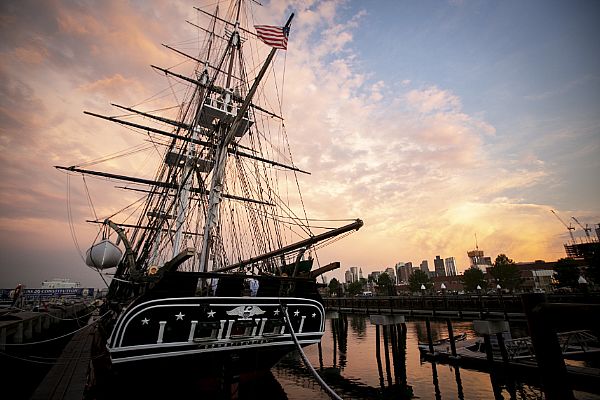
U.S. Navy photo by Chief Mass Communication Specialist Elliott Fabrizio (Released) 190819-N-ES994-1001. Accessed on USS Constitution Command Page (navy.mil/local/constitution).
You made it to the end! One final salute for your hard work.
